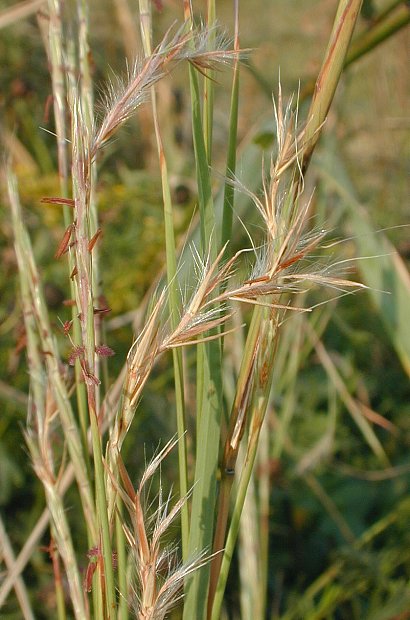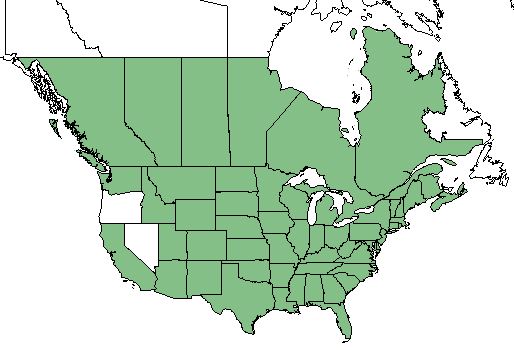Difference between revisions of "Schizachyrium scoparium"
| Line 25: | Line 25: | ||
==Description== | ==Description== | ||
<!-- Basic life history facts such as annual/perrenial, monoecious/dioecious, root morphology, seed type, etc. --> | <!-- Basic life history facts such as annual/perrenial, monoecious/dioecious, root morphology, seed type, etc. --> | ||
| − | ''S. scoparium'' is a perennial graminoid of the ''Poaceae'' family native to North America and Canada and introduced to Hawaii.<ref name= "USDA Plant Database"> USDA Plant Database [https://plants.usda.gov/core/profile?symbol=SCSC https://plants.usda.gov/core/profile?symbol=SCSC] </ref> | + | ''S. scoparium'' is a perennial graminoid of the ''Poaceae'' family native to North America and Canada and introduced to Hawaii.<ref name= "USDA Plant Database"> USDA Plant Database [https://plants.usda.gov/core/profile?symbol=SCSC https://plants.usda.gov/core/profile?symbol=SCSC] </ref> It is a primary groundcover species in longleaf pine forest. Bluestem grows both solitary and in clumps and reaches heights up to 4.5 feet tall with 10 inch long, narrow leaf blades. The plant possesses flowering spikes that grow on evenly distributed stalks up the stem. These flowers bloom in the fall and seeds disperse in November. There are a couple noted subspecies var. ''divergens'' (pinehill bluestem) and var. ''stoloniferum'' (creeping bluestem), the latter is only found in central longleaf pine range.<ref>Denhof, Carol. 2012. Plant Spotlight Schizachyrium Scoparium (Michx.) Nash var. scoparium Little Bluestem. The Longleaf Leader - Longleaf Reflections: Looking Back, Taking Stock, Moving Forward. Vol. XI. Iss. 3. Page 6</ref><ref>Miller, J.H. and K.V. Miller. Forest Plants of the Southeast and their Wildlife Uses. The University of Georgia Press, Atehns, GA. 454pp.</ref><ref>Sorries, B.A. 2011. A Field Guide to Wildflowers of the Sandhills Region. The University of North Carolina Press. Chapel Hill, NC. 378pp.</ref><ref>USDA, NRCS. 2018 The PLANTS Database (http://plants.usda.gov, 29 September 2011). National Plant Data Team, Greensboro, NC 27401-4901 USA.</ref> |
==Distribution== | ==Distribution== | ||
Revision as of 14:14, 17 June 2021
Common name: pinehill bluestem[1], common little bluestem[1], creeping little bluestem[1], little bluestem[2]
| Schizachyrium scoparium | |
|---|---|

| |
| Photo by John Hilty hosted at IllinoisWildflowers.info | |
| Scientific classification | |
| Kingdom: | Plantae |
| Division: | Magnoliophyta - Flowering plants |
| Class: | Liliopsida - Moncots |
| Order: | Poales |
| Family: | Poaceae |
| Genus: | Schizachyrium |
| Species: | S. scoparium |
| Binomial name | |
| Schizachyrium scoparium (Michx.) Nash | |

| |
| Natural range of Schizachyrium scoparium from USDA NRCS Plants Database. | |
Contents
Taxonomic Notes
Synonyms: (for var. divergens) Andropogon scoparius Michaux var. divergens Hackel; Andropogon divergens; (for var. scoparium) S. scoparium; S. scoparium ssp. scoparium; (for var. stoloniferum) S. stoloniferum Nash; Andropogon stolonifer (Nash) A.S. Hitchcock
Varieties: Schizachyrium scoparium (Michaux) Nash var. divergens (Hackel) Gould; Schizachyrium scoparium (Michaux) Nash var. scoparium; Schizachyrium scoparium (Michaux) Nash var. stoloniferum (Nash) J. Wipff
Description
S. scoparium is a perennial graminoid of the Poaceae family native to North America and Canada and introduced to Hawaii.[2] It is a primary groundcover species in longleaf pine forest. Bluestem grows both solitary and in clumps and reaches heights up to 4.5 feet tall with 10 inch long, narrow leaf blades. The plant possesses flowering spikes that grow on evenly distributed stalks up the stem. These flowers bloom in the fall and seeds disperse in November. There are a couple noted subspecies var. divergens (pinehill bluestem) and var. stoloniferum (creeping bluestem), the latter is only found in central longleaf pine range.[3][4][5][6]
Distribution
S. scoparium is found: everywhere in the United States excluding Oregon and Nevada; every region in Canada; every island in Hawaii.[2]
Ecology
Habitat
S. scoparium proliferates in various open habitats, in a wide range of moist to dry habitats, fall-line sandhills in the inner Coastal Plain, perhaps in other dry habitats. [1] It also occurs often in relic P. palustris/wiregrass communities. [7] Specimens have been collected from wet pine flatwoods, palmetto slash pine woodland, oak-palmetto woodland, blaffs along river, treeless chalk glade, wet road ditch, cypress swamp, dry glade, palm hammock, sand-pine oak woodland, slashpine savanna, longleaf pine sand ridge, pine flatwoods, longleaf pine wiregrass savanna, upland old field, pond pine flatwoods, and open river banks.[8] It is considered to be a species that is indicative of non-agricultural history on frequently burned longleaf pine habitat.[9] S. scoparium responds negatively to soil disturbance by agriculture in Southwest Georgia.[10]
Schizachyrium scoparium var. stoloniferum is frequent and abundant in the Peninsula Xeric Sandhills, Panhandle Xeric Sandhills, North Florida Subxeric Sandhills, Clayhill Longleaf Woodlands, Panhandle Silty Longleaf Woodlands, and Upper Panhandle Savannas community types as described in Carr et al. (2010).[11]
Phenology
S. scoparium has been observed to flower in November. [12]
Fire ecology
S. scoparium is highly fire tolerant, resprouting quickly following fire, and is the dominant grass species in some fire-dependent communities (e.g., western upland longleaf pine forest).[13] A study found overall herbivory to decrease with higher fire return interval regiments.[9]
Use by animals
S. scoparium has medium palatability for browsing animals and high palatability for grazing animals. [2] It is sometimes foraged by common grasshoppers in the subfamilies Melanoplinae and Cyrtacanthacridinae, which are known as mixed feeders.[9]
Conservation, cultivation, and restoration
Cultural use
Photo Gallery
References and notes
- ↑ 1.0 1.1 1.2 1.3 Weakley, A. S. (2015). Flora of the Southern and Mid-Atlantic States. Chapel Hill, NC, University of North Carolina Herbarium.
- ↑ 2.0 2.1 2.2 2.3 USDA Plant Database https://plants.usda.gov/core/profile?symbol=SCSC
- ↑ Denhof, Carol. 2012. Plant Spotlight Schizachyrium Scoparium (Michx.) Nash var. scoparium Little Bluestem. The Longleaf Leader - Longleaf Reflections: Looking Back, Taking Stock, Moving Forward. Vol. XI. Iss. 3. Page 6
- ↑ Miller, J.H. and K.V. Miller. Forest Plants of the Southeast and their Wildlife Uses. The University of Georgia Press, Atehns, GA. 454pp.
- ↑ Sorries, B.A. 2011. A Field Guide to Wildflowers of the Sandhills Region. The University of North Carolina Press. Chapel Hill, NC. 378pp.
- ↑ USDA, NRCS. 2018 The PLANTS Database (http://plants.usda.gov, 29 September 2011). National Plant Data Team, Greensboro, NC 27401-4901 USA.
- ↑ Andreu, M. G., et al. (2009). "Can managers bank on seed banks when restoring Pinus taeda L. plantations in Southwest Georgia?" Restoration Ecology 17: 586-596.
- ↑ URL: http://herbarium.bio.fsu.edu. Last accessed: June 2018. Collectors: R.K. Godfrey, Angus Gholson, Cecil Slaughter, Loran C. Anderson, Mark A> Garland, Marc Minno, Wilson Baker, Ann F. Johnson, R. Komarek, R. Kral, Richard S. Mitchell, R. E. Perdue, A.F. Clewell, Robert Blaisdell, Robert Lazor, Ginny Vail, Sidney McDaniel. States and counties: Georgia (Grady, Thomas, Baker) Alabama (Crenshaw) Louisiana (Winn) Florida (Grady, Okaloosa, Indian River, Franklin, Gadsden, Clay, Wakulla, Jackson, Volusia, Flagler, Leon, Walton, Bay, Escambia, Liberty, Columbia, Osceola, Marion, Taylor, Madison, Levy, Dixie, Baker, Calhoun, Okaloosa, Santa Rosa, Nassau)
- ↑ 9.0 9.1 9.2 Hahn, P. C. and J. L. Orrock (2015). "Land-use legacies and present fire regimes interact to mediate herbivory by altering the neighboring plant community." Oikos 124: 497-506.
- ↑ Hedman, C.W., S.L. Grace, and S.E. King. (2000). Vegetation composition and structure of southern coastal plain pine forests: an ecological comparison. Forest Ecology and Management 134:233-247.
- ↑ Carr, S.C., K.M. Robertson, and R.K. Peet. 2010. A vegetation classification of fire-dependent pinelands of Florida. Castanea 75:153-189.
- ↑ Nelson, G. PanFlora: Plant data for the eastern United States with emphasis on the Southeastern Coastal Plains, Florida, and the Florida Panhandle. www.gilnelson.com/PanFlora/ Accessed: 29 MAY 2018
- ↑ Smith, L. 2009. The natural communities of Louisiana. Louisiana Natural Heritage Program, Louisiana Department of Wildlife and Fisheries, 46 pp.